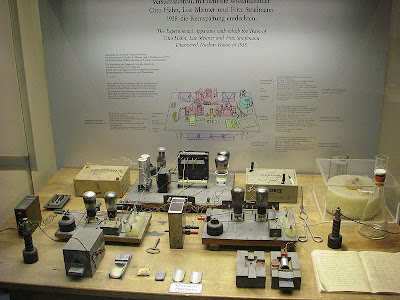Lise Meitner in the Ada Lovelace's day
 The Ada Lovelace's Day is a blogging international day to draw attention to women excelling in technology (The Ada Lovelace Day). To take part, you must to choose a tech heroine and then publish a blog post, any time on Tuesday 24th March 2010. Augusta Ada King, Countess of Lovelace (1815-1852), know today as Ada Lovelace, is mainly known for as the "first programmer" since she was writing programs for the early mechanical general-purpose computer, the Babbage's analytical engine.
The Ada Lovelace's Day is a blogging international day to draw attention to women excelling in technology (The Ada Lovelace Day). To take part, you must to choose a tech heroine and then publish a blog post, any time on Tuesday 24th March 2010. Augusta Ada King, Countess of Lovelace (1815-1852), know today as Ada Lovelace, is mainly known for as the "first programmer" since she was writing programs for the early mechanical general-purpose computer, the Babbage's analytical engine.
This year, my heroine is Lise Meitner ( Vienna, Austria, November 7, 1878. Cambridge, England, October 27, 1968) was an Austrian-born, later Swedish physicist who worked on radioactivity and nuclear physics. Meitner was part of the team that discovered nuclear fission, an achievement for which her colleague Otto Hahn was awarded the Nobel Prize by the Royal Swedish Academy of Sciences in 1945, overlooking Lise Meitner, who collaborated with him in the discovery and gave the first theoretical explanation of the fission process.
Meitner is often mentioned as one of the most glaring examples of women's scientific achievement overlooked by the Nobel committee. A 1997 study concluded that Meitner's omission was "a rare instance in which personal negative opinions apparently led to the exclusion of a deserving scientist" from the Nobel.
Lise Meitner was the third of eight children of a Viennese Jewish family. In 1908, two of Lise's sisters became Catholics and she herself became a Protestant. While conscientious, these conversions counted for nothing after Hitler came to power. Owing to Austrian restrictions on female education, Lise Meitner only entered the University of Vienna in 1901. With Ludwig Boltzmann as her teacher, she learned quickly that physics was her calling.
Doctorate in hand, she went to Berlin in 1907 to study with Max Planck. She began to work with a chemist, Otto Hahn, she doing the physics and he the chemistry of radioactive substances. The collaboration continued for 30 years, each heading a section in Berlin's Kaiser Wilhelm Institute for Chemistry. Together and independently they achieved important results in the new field of nuclear physics, competing with Irène Curie, Frédéric Joliot, and other foreign groups.
In 1934, Enrico Fermi produced radioactive isotopes by neutron bombardment, coming to a puzzle only with uranium. There were several products; were any of them transuranic elements? Meitner drew Hahn and also Fritz Strassmann into a new collaboration to probe the possibilities. By 1938, the puzzle had only grown.
After the Anschluss (German annexation of Austria in March 1938), Lise Meitner had to emigrate. In the summer of 1938, she went to Manne Siegbahn's institute in Stockholm. Neither asked to join Siegbahn's group nor given the resources to form her own, she had laboratory space but no collaborators, equipment, or technical support, not even her own set of keys..." She corresponded with Hahn as he and Strassmann tried to identify their "transuranes."
On November 13, 1938, Hahn met secretly with Meitner in Copenhagen. At her suggestion, Hahn and Strassmann performed further tests on a uranium product they thought was radium. When they found that it was in fact barium, they published their results in Naturwissenschaften (January 6, 1939). Simultaneously, Meitner and Frisch explained (and named) nuclear fission, using Bohr's "liquid drop" model of the nucleus; their paper appeared in Nature (February 11, 1939). The proof of fission required Meitner's and Frisch's physical insight as much as the chemical findings of Hahn and Strassmann
 But the separation of the former collaborators and Lise's scientific and actual exile led to the Nobel committee's failure to understand her part in the work. Later Hahn rationalized her exclusion and others buried her role ever deeper. The Nobel "mistake", never acknowledged, was partly rectified in 1966, when Hahn, Meitner, and Strassmann were awarded the U.S. Fermi Prize.
But the separation of the former collaborators and Lise's scientific and actual exile led to the Nobel committee's failure to understand her part in the work. Later Hahn rationalized her exclusion and others buried her role ever deeper. The Nobel "mistake", never acknowledged, was partly rectified in 1966, when Hahn, Meitner, and Strassmann were awarded the U.S. Fermi Prize.
In 1997, element 109 was named Meitnerium (Mt) in her honour.
No chemical element has received the name of her colleague Hahn.... poetic justice?























Excellent and educational post!
ReplyDelete